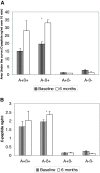Syndromes of ketosis-prone diabetes mellitus
- PMID: 18292467
- PMCID: PMC2528854
- DOI: 10.1210/er.2007-0026
Syndromes of ketosis-prone diabetes mellitus
Abstract
Ketosis-prone diabetes (KPD) is a widespread, emerging, heterogeneous syndrome characterized by patients who present with diabetic ketoacidosis or unprovoked ketosis but do not necessarily have the typical phenotype of autoimmune type 1 diabetes. Multiple, severe forms of beta-cell dysfunction appear to underlie the pathophysiology of KPD. Until recently, the syndrome has lacked an accurate, clinically relevant and etiologically useful classification scheme. We have utilized a large, longitudinally followed, heterogeneous, multiethnic cohort of KPD patients to identify four clinically and pathophysiologically distinct subgroups that are separable by the presence or absence of beta-cell autoimmunity and the presence or absence of beta-cell functional reserve. The resulting "Abeta" classification system of KPD has proven to be highly accurate and predictive of such clinically important outcomes as glycemic control and insulin dependence, as well as an aid to biochemical and molecular investigations into novel causes of beta-cell dysfunction. In this review, we describe the current state of knowledge in regard to the natural history, pathophysiology, and treatment of the subgroups of KPD, with an emphasis on recent advances in understanding their immunological and genetic bases.
Figures


References
-
- Maldonado M, Hampe CS, Gaur LK, D’Amico S, Iyer D, Hammerle LP, Bolgiano D, Rodriguez L, Rajan A, Lernmark A, Balasubramanyam A 2003 Ketosis-prone diabetes: dissection of a heterogeneous syndrome using an immunogenetic and β-cell functional classification, prospective analysis, and clinical outcomes. J Clin Endocrinol Metab 88:5090–5098 - PubMed
-
- Balasubramanyam A, Garza G, Rodriguez L, Hampe CS, Gaur L, Lernmark A, Maldonado MR 2006 Accuracy and predictive value of classification schemes for ketosis-prone diabetes. Diabetes Care 29:2575–2579 - PubMed
-
- Adadevoh BK 1968 “Temporary diabetes” in adult Nigerians. Trans R Soc Trop Med Hyg 62:528–530 - PubMed
-
- Oli JM 1978 Remittent diabetes mellitus in Nigeria. Trop Geogr Med 30:57–62 - PubMed
Publication types
MeSH terms
Grants and funding
LinkOut - more resources
Full Text Sources
Medical
Molecular Biology Databases

